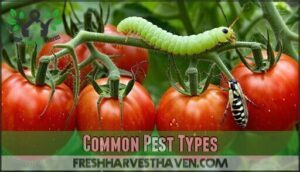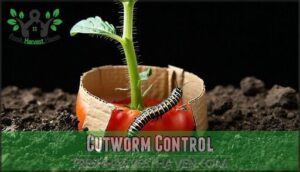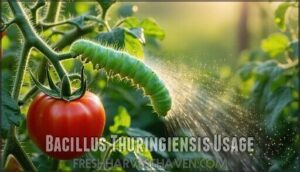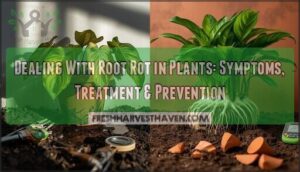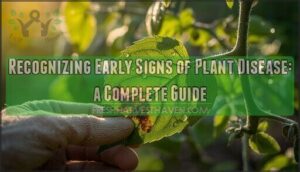This site is supported by our readers. We may earn a commission, at no cost to you, if you purchase through links.
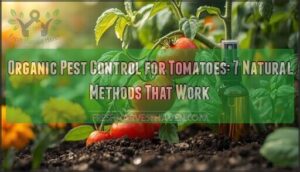
Neem oil works as both pesticide and fungicide, while beneficial insects like ladybugs provide natural predation. Create physical barriers using row covers, practice companion planting with basil and marigolds, and encourage biodiversity in your garden.
These methods eliminate harmful chemicals while maintaining effective pest management. Hand-picking larger pests like hornworms offers immediate results, and proper crop rotation breaks pest cycles naturally.
Each technique addresses specific pest challenges while keeping your harvest chemical-free.
Table Of Contents
- Key Takeaways
- Organic Pest Control Methods
- Identifying Tomato Pests
- Biological Control Techniques
- Managing Pest Infestations
- Maintaining Healthy Tomatoes
- Frequently Asked Questions (FAQs)
- What is the best natural pest control for tomatoes?
- How to treat tomato plants organically?
- What is the best thing to keep bugs off tomato plants?
- How do I stop my tomatoes from being eaten?
- How do you keep pests away from tomato plants?
- How to make pesticides for tomato plants?
- Do pests eat tomato plants?
- How do you deal with tomato pests & diseases?
- Can you use bug repellent on tomato plants?
- How do you kill Bugs on tomato plants?
- Conclusion
Key Takeaways
- You’ll protect your tomatoes naturally by combining multiple organic methods, like insecticidal soap for soft-bodied pests, neem oil as a dual pesticide-fungicide, and beneficial insects like ladybugs for long-term control.
- Physical barriers work immediately – use row covers to block flying insects, cardboard collars around stems to prevent cutworms, and companion planting with basil and marigolds to naturally repel pests.
- Early detection prevents major infestations – inspect your plants daily, especially the leaf undersides where pests congregate, and watch for yellowing leaves, holes, or stunted growth as warning signs.
- Healthy soil creates pest-resistant plants – strong tomatoes from organic fertilizers, proper crop rotation, and compost naturally withstand pest pressure better than chemically treated plants.
Organic Pest Control Methods
When tomato pests threaten your garden, you don’t need harsh chemicals to protect your plants.
These natural pest control methods work effectively while keeping your tomatoes safe for eating and maintaining a healthy garden ecosystem.
Insecticidal Soap Usage
Insecticidal soap effectively controls soft-bodied tomato pests like aphids, whiteflies, and spider mites through direct contact.
You’ll achieve ideal pest control tomatoes results by applying during cooler morning or evening hours to prevent plant sensitivity issues.
Stink bugs can also damage tomatoes by sucking juices from the young fruit.
- Soap Application: Mix 1-2 teaspoons commercial insecticidal soap per pint of water for proper mixing ratios
- Target Coverage: Spray undersides of leaves where tomato plant pests congregate, ensuring thorough contact
- Timing Matters: Reapply weekly until infestation clears, avoiding residue effects through proper dilution
Commercial potassium-based soap alternatives outperform homemade versions for organic pest control while reducing plant damage risks.
Horticultural Oils Application
Horticultural oils offer powerful organic pest control for tomatoes through precise application timing and proper dilution ratios.
These refined mineral or plant-derived oils target aphids, spider mites, and whiteflies by suffocating them on contact.
Apply at 1-2% dilution when temperatures stay below 80°F to prevent plant sensitivity issues.
Unlike synthetic pesticides, these oils leave minimal residue effects while providing effective tomato plant care in your organic gardening system. They’re considered a type of suffocant pesticide, which is a crucial aspect of tomato plant care and using horticultural oils.
Natural Sprays Preparation
Creating effective DIY recipes for natural pest control starts with simple household ingredients.
Mix garlic-based herbal infusions by pureeing bulbs in water, then strain and add soap solutions for better leaf adhesion. Essential oils like rose extract deter pests while attracting beneficial insects.
Hot pepper sprays using cayenne powder create powerful natural pest repellents. A ready-made natural spray option is also available.
These application methods offer safe, organic pest management alternatives to synthetic chemicals for your tomato plants, providing a safe and efficient way to protect them.
Neem Oil Benefits
Neem oil stands as your garden’s Swiss Army knife for organic pest management.
This natural extract disrupts pest life cycles while remaining gentle on beneficial insects when applied correctly.
Mix one to two tablespoons per gallon of water, adding a few drops of mild dish soap for better adhesion.
Apply during cooler evening hours to prevent leaf burn and maximize effectiveness.
Neem oil’s systemic properties provide protection for up to two weeks, making it ideal for tomato compatibility and sustainable pest control.
Beneficial Insects Role
Nature’s army stands ready to defend your tomato plants.
Attracting predators through habitat creation transforms your garden into a biological pest control fortress. These beneficial insects provide natural pest control while maintaining ecosystem balance.
Key tomato pest control tips:
- Ladybugs – consume up to 400 aphids during larval development
- Parasitic wasps – target hornworms and leafminers with 60% kill rates
- Predatory mites – specialize in controlling spider mites effectively
Pollinator support through companion planting creates sustainable organic pest control methods.
Gardeners should also consider using row covers for protection.
Identifying Tomato Pests
Before you can protect your tomatoes, you need to know what you’re fighting against.
Learning to spot the telltale signs of pest damage will help you catch problems early and choose the right organic treatment for each specific invader.
This knowledge is crucial for effective protection of your tomatoes.
Common Pest Types
You’ll encounter five primary tomato insects that can devastate your crop.
Understanding pest control for tomatoes starts with proper tomato pest identification to implement effective organic pest control methods.
| Pest Type | Key Identification | Primary Damage |
|---|---|---|
| Tomato hornworms | Large green caterpillars up to 4 inches | Strip foliage within days |
| Aphid identification | Small clusters on leaf undersides | Yellowing, curling leaves |
| Flea beetles | Tiny jumping insects | Small round holes in leaves |
| Cutworm species | Night-feeding larvae in soil | Sever stems at base |
| Whiteflies impact | Tiny white flying insects | Sticky honeydew, viral transmission |
Each pest requires specific strategies, making accurate identification your first defense against tomato diseases.
Signs of Infestation
Spotting trouble early puts you ahead of pest problems that can devastate your crop.
Watch for these warning signs that indicate tomato insects or diseases have invaded your garden:
- Leaf Damage – Yellow spots, holes, or wilting leaves signal immediate attention needed
- Fruit Spots – Dark patches or unusual markings on tomatoes indicate developing problems
- Stunted Growth – Plants that stop growing normally often harbor hidden pests
- Visible Pests – Spotting actual insects means the infestation has already begun spreading
Preventive Measures
Prevention starts with healthy seedlings from reputable sources, as strong starts resist pest problems better than weakened plants.
Practice garden hygiene by removing plant debris and rotating crops annually to break pest cycles.
Soil solarization during hot months eliminates overwintering pests, while netting barriers physically block flying insects.
These organic pest prevention strategies create the foundation for robust tomato plant health through proactive organic crop management.
Cutworm Control
Cutworms attack young tomato seedlings at night, severing stems at soil level.
These silent night raiders can destroy your seedlings before dawn breaks.
These nocturnal garden pests hide in soil during daylight, making detection challenging.
Understanding the cutworm lifecycle helps time your organic pest control solutions effectively.
Protect your tomatoes with these physical barriers and natural methods:
- Collar installation – Place cardboard tubes around seedling stems, extending 2 inches below and above soil
- Soil solarization – Cover moist soil with clear plastic for 4-6 weeks to eliminate larvae
- Natural predators – Encourage ground beetles and birds that feed on cutworms
- Evening inspection – Hand-pick cutworms found near damaged plants using flashlight
- Organic pesticides – Apply Bacillus thuringiensis at soil level during active feeding periods
Aphid Management
Aphids cluster on tomato stems and leaves, creating sticky honeydew that attracts ants.
These soft-bodied garden pests multiply rapidly through their complex aphid lifecycle, but you can control them using natural predators like ladybugs and lacewings.
| Prevention Strategies | Homemade Solutions |
|---|---|
| Plant companion plants (marigolds, basil) | Spray soapy water mixture |
| Encourage beneficial insects | Apply neem oil treatment |
| Regular garden monitoring | Use garlic-pepper spray |
These organic pesticides and pest control solutions protect your organic tomato farming efforts while addressing common tomato problems naturally.
Biological Control Techniques
Biological control methods harness nature’s own pest management systems to protect your tomato plants without synthetic chemicals.
These techniques work by introducing beneficial organisms and creating conditions that naturally suppress harmful pests while promoting plant health.
Bacillus Thuringiensis Usage
Bacillus thuringiensis (Bt) delivers targeted pest control by specifically attacking caterpillars like tomato hornworms and cabbage loopers while sparing beneficial insects.
You’ll achieve maximum BT effectiveness by applying this organic insecticide during evening hours when UV light won’t degrade its potency.
Mix the wettable powder according to label instructions, then spray directly onto foliage where target pests feed.
This biological weapon causes larvae to stop eating within days, offering superior safety compared to synthetic alternatives for your tomato problems.
Crop Rotation Benefits
Rotating your tomatoes breaks pest cycles that build up in soil over time.
When you plant different crops each season, soil-dwelling pests lose their preferred food source and naturally decline.
This practice improves soil health through varied nutrient cycling, reduces weed control needs, and ultimately increases yield in your organic farming system.
Natural Barriers Creation
Physical barriers shield your tomatoes from crawling and flying pests without chemicals.
These organic gardening techniques create protective boundaries that stop insects before they reach your plants.
- Row Covers – Lightweight fabric that blocks pests while allowing light and water through
- Copper Tape – Creates electrical barriers that deter slugs and snails naturally
- Plant Collars – Cardboard rings around stems prevent cutworm damage at soil level
- Mesh Netting – Fine screens exclude flying insects from accessing tomato foliage
These barriers can be enhanced by companion planting strategies to naturally deter pests.
Companion Planting Benefits
Smart companion planting transforms your garden into a natural fortress against pests.
Basil and marigolds planted near tomato plants release compounds that deter aphids and whiteflies, while onions reduce spider mite infestations by 40%.
These organic pest solutions create biodiversity boost that strengthens your entire garden ecosystem, offering growth support through soil enrichment and enhanced tomato flavors, ultimately leading to a healthier and more resilient garden.
Encouraging Beneficial Insects
You’ll want to create inviting spaces that naturally draw beneficial insects to your tomato garden.
Plant insectary plants like yarrow, dill, and sweet alyssum nearby to provide habitat creation for predators such as ladybugs and lacewings.
These pollinator gardens establish natural ecosystems that support organic pest control techniques, making your tomato plant protection efforts more effective through proven organic gardening practices for tomatoes.
Managing Pest Infestations
When you spot pests on your tomato plants, you’ll need to act quickly and choose the right organic solution for each problem.
Understanding specific control methods for aphids, cutworms, flea beetles, fungal issues, and hornworms helps you protect your crop while maintaining a healthy garden ecosystem.
Controlling Aphids
Aphids cluster on tomato leaves like tiny green vampires, but you can send them packing with smart organic pest control strategies.
Blast them off with strong water sprays, then deploy aphid predators like ladybugs and lacewings.
Install reflective mulch around plants to confuse these pests, while sticky traps catch stragglers, and companion plants like marigolds provide natural tomato plant protection through their pest-repelling properties.
Treating Cutworms
Cutworms strike at night, severing young tomato stems at soil level.
Create Physical Barriers using cardboard collars around seedlings, pushing them one inch into soil.
Sprinkle Diatomaceous Earth around plants—this razor-sharp powder cuts soft cutworm bodies.
For serious infestations, apply beneficial Nematode Control to soil.
Conduct Nocturnal Patrols with flashlights to handpick these sneaky pests.
Managing Flea Beetles
Flea beetles pose a persistent threat to tomato seedlings, creating small holes that weaken plants.
These tiny jumping insects require targeted organic pest control strategies to prevent serious damage.
- Flea Beetle Traps: Deploy Yellow Sticky Traps around plants to capture adults before they reproduce
- Diatomaceous Earth: Sprinkle food-grade powder around plant bases to create abrasive barriers that deter beetles
- Row Covers: Install lightweight fabric barriers over young plants, removing once flowering begins for pollination
Companion Plants like nasturtiums and radishes naturally repel flea beetles while organic insecticides provide additional protection when infestations occur.
Improving soil health can further strengthen plant defenses by feeding soil microorganisms.
Organic Fungicides Application
Fungal diseases can devastate your tomato crop faster than you’d expect.
You’ll need proven organic fungicides for effective disease prevention. Apply copper-based products every 7-14 days, starting before symptoms appear. Proper application timing matters most for success.
| Fungicide Types | Target Diseases | Application Timing |
|---|---|---|
| Copper sulfate | Blight, anthracnose | Every 7-14 days |
| Bacillus pumilus | Powdery mildew, blight | Preventive spraying |
| Neem oil | Gray mold, anthracnose | After rain periods |
| Hydrogen peroxide | Root rots, leaf mold | Weekly intervals |
| Potassium bicarbonate | Surface fungi | pH management |
Hornworm Control
Hornworms can devastate your tomato plants overnight, but you can fight back with targeted organic strategies.
These green caterpillars blend perfectly with foliage, making detection challenging.
Effective hornworm control methods:
- Handpicking Hornworms – Check plants daily at dawn when they’re most active
- Bt Application – Spray Bacillus thuringiensis on affected areas every 7-14 days
- Parasitic Wasps – Encourage braconid wasps that naturally target hornworms
Companion Plants like marigolds and basil help deter these pests.
Decoy Planting with dill draws hornworms away from tomatoes.
These pest control strategies form thorough organic pest management for tomatoes, ensuring effective organic crop protection for tomatoes through proven organic gardening tips for tomatoes and sustainable tomato plant pest management.
Maintaining Healthy Tomatoes
Once you’ve tackled the immediate pest problems, you’ll need to focus on prevention through healthy soil and smart growing practices.
Strong tomato plants naturally resist pests better, so maintaining proper nutrition and monitoring your garden regularly becomes your best long-term defense strategy.
Soil Fertility Importance
Healthy soil acts as your tomato plants’ foundation for natural pest resistance.
Rich Organic Matter improves Soil Structure while boosting Microbial Activity that breaks down nutrients your plants need.
Better Water Retention means stronger root systems that can withstand pest pressure.
Focus on Nutrient Availability through organic soil management—composting and organic practices create the ideal environment for robust tomato cultivation and effective soil health maintenance.
Ongoing Garden Observation
Regular observation forms the backbone of effective organic pest control for tomatoes, helping you catch problems before they spiral out of control.
Check your plants daily, noting pest life cycles and weather impact on plant health trends.
Monitor soil condition monitoring for moisture and nutrient levels while practicing early problem detection through leaf inspection.
This vigilant approach to organic crop health guarantees your tomato plant diseases and pest control strategies for tomatoes remain effective throughout the growing season, ensuring effective management of plant health.
Companion Planting Strategies
Strategic companion planting transforms your tomato garden into a natural pest-fighting fortress. You’ll create synergistic relationships that boost plant health while deterring harmful insects through nature’s own defense mechanisms.
Effective companion planting strategies for organic pest control for tomatoes:
- Attracting Pollinators – Plant marigolds and nasturtiums nearby to draw beneficial insects that eliminate aphids and whiteflies
- Repelling Pests – Use basil and oregano for natural pest deterrence while enhancing tomato flavor through aromatic compounds
- Soil Enrichment – Integrate nitrogen-fixing legumes like beans to improve soil fertility and support robust tomato growth
- Space Optimization – Employ vertical companion planting with herbs underneath tall tomato plants, maximizing garden productivity and pest protection
Organic Fertilizers Usage
Beyond companion planting, organic fertilizers provide the foundation for robust tomato plants that naturally resist pests.
Compost teas deliver nutrients while promoting beneficial soil microbes that strengthen plant defenses. Manure application supports nutrient cycling, creating conditions where organic techniques thrive.
Well-fed plants from organic methods and sustainable sourcing practices develop stronger cell walls, making them less attractive to harmful insects, and this is due to the use of organic fertilizers and the promotion of beneficial soil microbes.
Pest Monitoring Techniques
Weekly visual inspections form the backbone of effective organic pest control strategies, requiring you to examine at least five leaves per plant with a magnifying glass.
Focus your trap placement using yellow sticky cards at one per 1,000 square feet for early detection of flying pests.
Document findings through data logging to track population trends, enabling precise pest identification and timely deployment of organic methods when action thresholds are reached.
Implementing these methods helps with identifying tomato pests early on.
Frequently Asked Questions (FAQs)
What is the best natural pest control for tomatoes?
Like guardian angels protecting their charges, beneficial insects wage invisible warfare against tomato pests.
You’ll get excellent results using companion planting with basil, releasing ladybugs for aphids, applying neem oil spray, and encouraging birds with water sources nearby, which can be considered a form of companion planting.
How to treat tomato plants organically?
You can treat tomato plants organically using companion planting, neem oil sprays, beneficial insects like ladybugs, crop rotation, compost amendments, and removing affected leaves promptly.
What is the best thing to keep bugs off tomato plants?
You’ll want to spray neem oil or diatomaceous earth around your plants—they’re natural bug deterrents that won’t harm beneficial insects. Companion planting with marigolds also helps repel pests naturally.
How do I stop my tomatoes from being eaten?
Your precious tomatoes are under siege! Use companion planting with basil and marigolds, apply neem oil spray, install row covers, and handpick larger pests to protect your harvest naturally.
How do you keep pests away from tomato plants?
Plant marigolds, basil, and nasturtiums around your tomatoes—they’ll naturally repel harmful insects. Spray neem oil weekly, handpick larger pests like hornworms, and encourage beneficial predators with diverse plantings.
How to make pesticides for tomato plants?
Mix equal parts water and mild dish soap in a spray bottle.
Add crushed garlic or neem oil for stronger protection.
Spray directly on affected leaves during cooler hours to avoid plant damage.
Do pests eat tomato plants?
Yes, various pests actively attack tomato plants, targeting leaves, stems, fruits, and roots. Common culprits include hornworms, aphids, cutworms, and whiteflies, which can devastate your harvest if left unchecked.
How do you deal with tomato pests & diseases?
Combat tomato pests by using companion planting, row covers, and beneficial insects like ladybugs.
For diseases, make certain of proper spacing, water at soil level, and apply organic fungicides when needed.
Can you use bug repellent on tomato plants?
Consumer bug repellents aren’t safe for tomato plants.
Instead, you’ll want organic options like neem oil, insecticidal soap, or diatomaceous earth.
These target pests without harming your plants or making fruits unsafe to eat, using methods like insecticidal soap.
How do you kill Bugs on tomato plants?
You’ll need to address unwanted garden visitors using targeted organic methods.
Apply neem oil spray, introduce beneficial insects like ladybugs, use diatomaceous earth around plants, or create soapy water solutions for effective pest management.
Apply these methods to ensure a healthy and thriving garden.
Conclusion
Like a fortress protecting its precious treasure, effective organic pest control for tomatoes creates multiple layers of defense against invading insects.
You’ve learned seven natural methods that work together harmoniously—from beneficial insects patrolling your plants to companion flowers standing guard alongside your tomatoes.
These chemical-free techniques don’t just eliminate pests; they build a thriving ecosystem where your plants naturally resist damage.
Start implementing these organic pest control strategies today, and you’ll discover that nature provides the most reliable protection for your homegrown harvest, with methods that work together harmoniously to ensure the best results.


